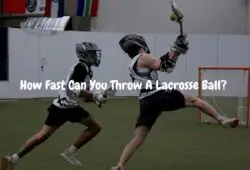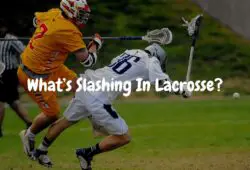While having my morning coffee just now, I saw a player ask a question about warding and the legality of using arms to defend players. It caused some discussion around the rules as well as some confusion. Given that the rules change both at NCAA and NFHS levels every now and then, it makes sense for players and coaches to misremember the exact clause. Thus, to help you eradicate all the confusion once and for all, let’s talk about the warding penalty in lacrosse you need to know.
But first, let’s define what warding is. Warding is a penalty in lacrosse that occurs when a player with the ball possession uses his/her free hand or arm to physically hold, move or block an opposing player or their stick. Although warding is clearly defined in the rulebook, in actual games the judgment solely depends on the officials and situations. This is why warding is a controversial topic that players and coaches don’t seem to always agree with the officials.
To avoid being called foul, let’s break down warding in depth regarding the current rules and how you could use other effective ways to maintain possession legally and effectively.
Read also: Lacrosse Rules Beginners Must Know
Overview of warding in lacrosse
Before I started playing lacrosse, I didn’t know the word warding existed. It’s again one of those terms and phrases that are innate to the lacrosse community. Thus, as mentioned earlier, warding is a penalty when a player removes one of their hands from the lacrosse stick to shove, hold or block the defender.
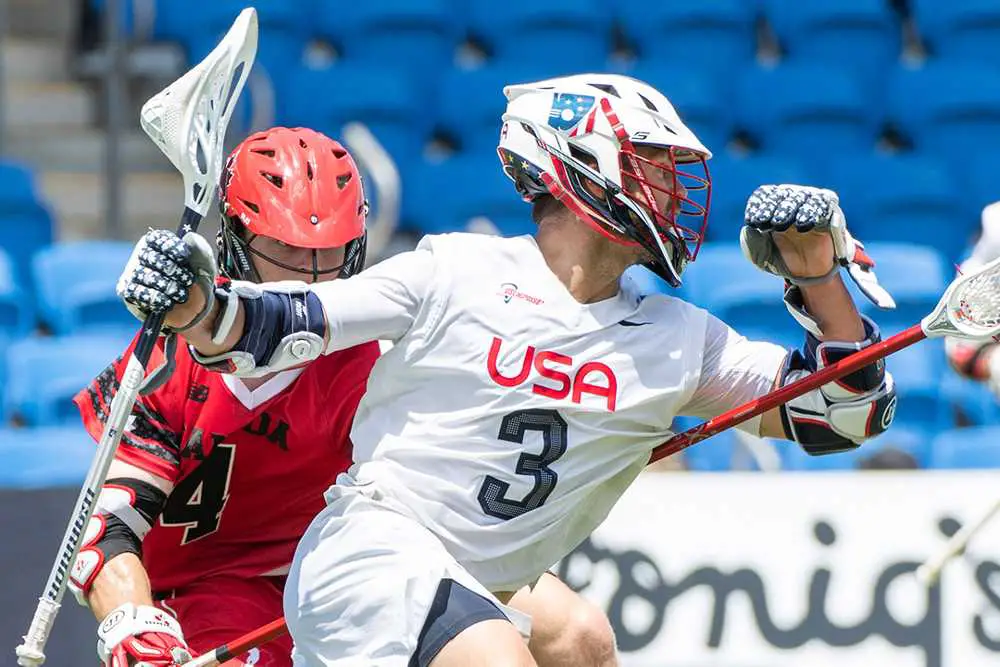
According to the NFHS rulebook, it says, “ A player in possession of the ball shall not use his free hand or arm, push or control the direction of the movement of the crosse or body of the player applying the check. A player in possession of the ball may protect his crosse with his hand, arm or other part of his body when his opponent makes a play to check his crosse.”
However, in 2019, NFHS amended this rule by adding a new clause that a player in possession of the ball with both hands on his stick shall not use his hand or arm to push the body of the player applying the check. “6.11 SITUATION C: A1, with both hands on his crosse, raises his forearm and directs B1’s (a) crosse or (b) body away from himself, creating space. RULING: (a) legal play. (b) warding off; award the ball to Team B.” (Source)
This differs from the old rule which allowed the player in possession of the ball to move or control the movements of another player as long as they have both hands on the stick. Now the contact with the body of another player is considered a ward even if the attacker has both hands on the stick, but contact with the opponent’s stick is not.
Situations where warding doesn’t apply
Because there’s a factor of subjectivity involved when determining what is a ward and what isn’t, officials allow the use of free arms on some occasions. For example, when a player who is in possession of the ball anticipates a check from the defender, they may use their free arm or hand to defend their stick without extending their arm outward. However, once the use of the free arm begins to push or block the other player, a warding will be given.
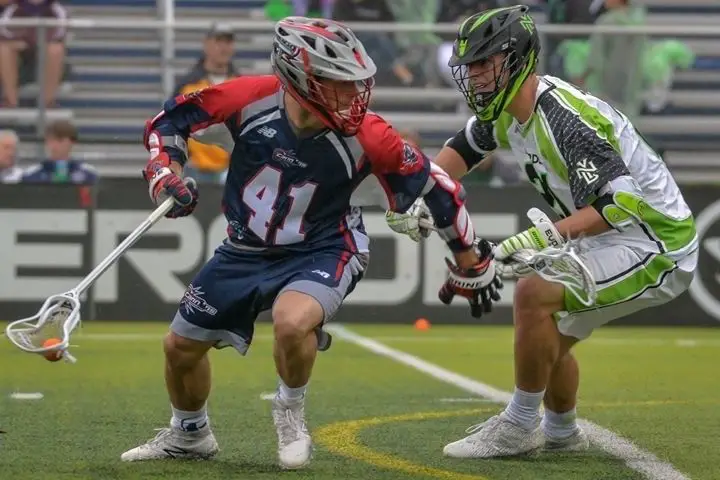
Moreover, on the subject of extending free arms, a very common form of warding in lacrosse is stiff arms. This also causes some confusion since stiff arms are allowed in other sports but not in lacrosse, so we will discuss stiff arms in the next section.
A common form of warding: Stiff Arms
When stiff arming an opponent, a player is extending his free arm to push or pull the opponent out of the way. Since this is a very obvious form of warding, stiff arm is penalized almost 100% of the time regardless of the situation.
Lacrosse has strict rules on any conspicuous arm extension, using free hands to shove or hold opponents and intentional contact with the opponent’s body. As soon as a player enacts anything that fits the above categories, officials will blow the whistle or throw the yellow flag to the field. Hence, in an advanced level of lacrosse, you rarely see laxers risk attempting to stiff arm.
Instead, stiff arming is a common mistake among beginners especially players who transition from other contact sports such as football. From my understanding, stiff arms are legal in sports like football due to the emphasis on body strength and power. But lacrosse is never a sport that prioritizes body collisions above other factors.
On the opposite, lacrosse promotes agility, speed and flexibility. Best players don’t use physical contact as their primary weapon but rather great footwork and stick skills. Hence, the lacrosse community as a whole has made the decision to discourage stiff arms, and warding in general.
What are some other ways to maintain ball possession
So if players can’t use stiff arm to maintain their possession, what are some alternative ways they could utilize to carry the ball safely and surely under opposing pressure? Let’s find out in this section.
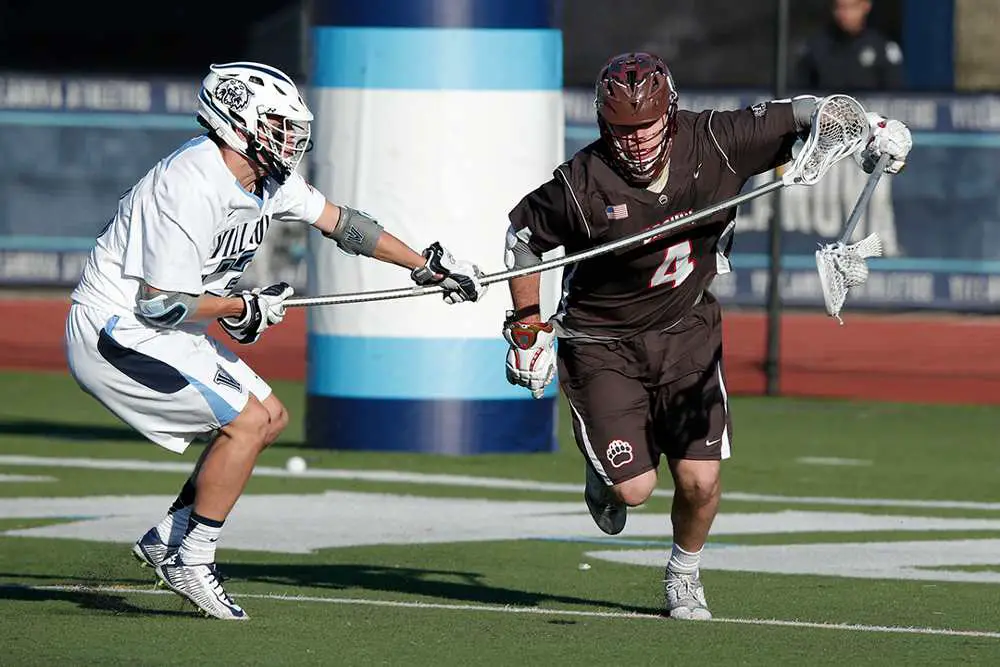
One Handed Cradling
You see this done by professional players a lot. When they are going into the offensive area, they utilize one handed cradling to separate the defender from the ball. They use their body as a natural barrier to keep defenders at bay.
Not only just using their dominant hand, best lacrosse players are also able to do one handed cradling with both hands. This gives players even more leverage regardless which side they are attacking the goal from. To avoid being called for warding, remember to keep your free arm to your body and stationary. If you are a beginner, don’t wait to learn how to do one handed cradling. Start today because it will be a very useful technique that serves you well down the line.
Dodging
To maintain possession, you need to create as much space as possible between you and the defender. So another popular method that lacrosse players often utilize is dodging. When you are in possession of the ball, as long as your feet are quicker than your defender’s, using dodging to change directions and to further create separation is very effective.
The idea is that defenders are always looking for physical contact so they can jar loose the ball out of your stick. If you are able to be faster on your feet than him and be stronger than him, you will not give him the chance to get even close to you.
Here is a great video that demonstrates the top 5 best dodges you need to learn
Conclusion
The biggest takeaway from this post is to know warding is absolutely not allowed in lacrosse. And one common form of warding players needs to be aware of is stiff arm. It’s imperative to learn the correct rules early on in your career so you develop the right techniques and avoid bad habits.
For more training content, head to this page to learn more.


